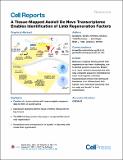| dc.contributor.author | Bryant, Donald M. | |
| dc.contributor.author | Johnson, Kimberly | |
| dc.contributor.author | DiTommaso, Tia | |
| dc.contributor.author | Tickle, Timothy | |
| dc.contributor.author | Couger, Matthew Brian | |
| dc.contributor.author | Payzin-Dogru, Duygu | |
| dc.contributor.author | Lee, Tae J. | |
| dc.contributor.author | Leigh, Nicholas D. | |
| dc.contributor.author | Kuo, Tzu-Hsing | |
| dc.contributor.author | Davis, Francis G. | |
| dc.contributor.author | Bateman, Joel | |
| dc.contributor.author | Bryant, Sevara | |
| dc.contributor.author | Guzikowski, Anna R. | |
| dc.contributor.author | Tsai, Stephanie L. | |
| dc.contributor.author | Coyne, Steven | |
| dc.contributor.author | Ye, William W. | |
| dc.contributor.author | Freeman, Robert M. | |
| dc.contributor.author | Peshkin, Leonid | |
| dc.contributor.author | Tabin, Clifford J. | |
| dc.contributor.author | Whited, Jessica L. | |
| dc.contributor.author | Regev, Aviv | |
| dc.contributor.author | Haas, Brian | |
| dc.date.accessioned | 2017-06-13T19:04:14Z | |
| dc.date.available | 2017-06-13T19:04:14Z | |
| dc.date.issued | 2017-01 | |
| dc.date.submitted | 2016-10 | |
| dc.identifier.issn | 2211-1247 | |
| dc.identifier.uri | http://hdl.handle.net/1721.1/109834 | |
| dc.description.abstract | Mammals have extremely limited regenerative capabilities; however, axolotls are profoundly regenerative and can replace entire limbs. The mechanisms underlying limb regeneration remain poorly understood, partly because the enormous and incompletely sequenced genomes of axolotls have hindered the study of genes facilitating regeneration. We assembled and annotated a de novo transcriptome using RNA-sequencing profiles for a broad spectrum of tissues that is estimated to have near-complete sequence information for 88% of axolotl genes. We devised expression analyses that identified the axolotl orthologs of cirbp and kazald1 as highly expressed and enriched in blastemas. Using morpholino anti-sense oligonucleotides, we find evidence that cirbp plays a cytoprotective role during limb regeneration whereas manipulation of kazald1 expression disrupts regeneration. Our transcriptome and annotation resources greatly complement previous transcriptomic studies and will be a valuable resource for future research in regenerative biology. | en_US |
| dc.description.sponsorship | United States. National Institutes of Health (1U24CA180922-01) | en_US |
| dc.language.iso | en_US | |
| dc.publisher | Elsevier | en_US |
| dc.relation.isversionof | http://dx.doi.org/10.1016/j.celrep.2016.12.063 | en_US |
| dc.rights | Creative Commons Attribution-NonCommercial-NoDerivs License | en_US |
| dc.rights.uri | http://creativecommons.org/licenses/by-nc-nd/4.0/ | en_US |
| dc.source | Elsevier | en_US |
| dc.title | A Tissue-Mapped Axolotl De Novo Transcriptome Enables Identification of Limb Regeneration Factors | en_US |
| dc.type | Article | en_US |
| dc.identifier.citation | Bryant, Donald M.; Johnson, Kimberly; DiTommaso, Tia; Tickle, Timothy; Couger, Matthew Brian; Payzin-Dogru, Duygu; Lee, Tae J. et al. “A Tissue-Mapped Axolotl De Novo Transcriptome Enables Identification of Limb Regeneration Factors.” Cell Reports 18, no. 3 (January 2017): 762–776 © 2016 The Author(s) | en_US |
| dc.contributor.department | Broad Institute of MIT and Harvard | en_US |
| dc.contributor.mitauthor | Regev, Aviv | |
| dc.contributor.mitauthor | Haas, Brian | |
| dc.relation.journal | Cell Reports | en_US |
| dc.eprint.version | Final published version | en_US |
| dc.type.uri | http://purl.org/eprint/type/JournalArticle | en_US |
| eprint.status | http://purl.org/eprint/status/PeerReviewed | en_US |
| dspace.orderedauthors | Bryant, Donald M.; Johnson, Kimberly; DiTommaso, Tia; Tickle, Timothy; Couger, Matthew Brian; Payzin-Dogru, Duygu; Lee, Tae J.; Leigh, Nicholas D.; Kuo, Tzu-Hsing; Davis, Francis G.; Bateman, Joel; Bryant, Sevara; Guzikowski, Anna R.; Tsai, Stephanie L.; Coyne, Steven; Ye, William W.; Freeman, Robert M.; Peshkin, Leonid; Tabin, Clifford J.; Regev, Aviv; Haas, Brian J.; Whited, Jessica L. | en_US |
| dspace.embargo.terms | N | en_US |
| dc.identifier.orcid | https://orcid.org/0000-0001-8567-2049 | |
| mit.license | PUBLISHER_CC | en_US |
| mit.metadata.status | Complete | |
